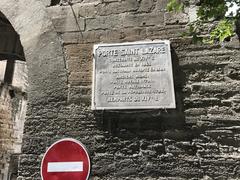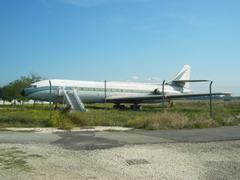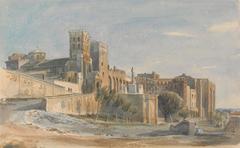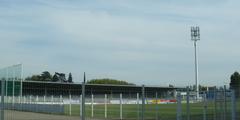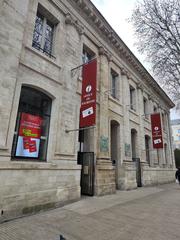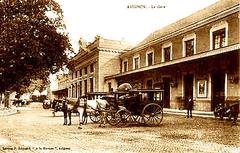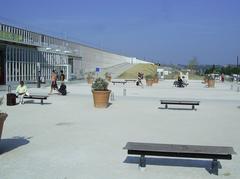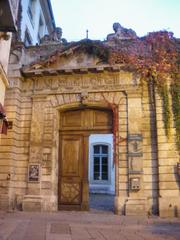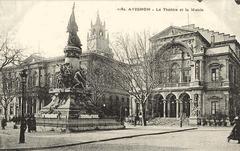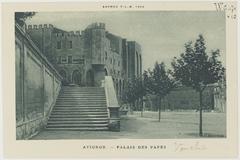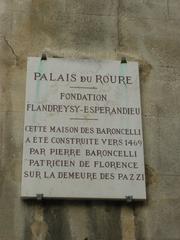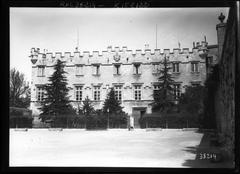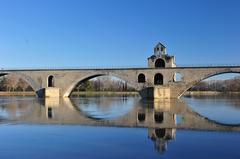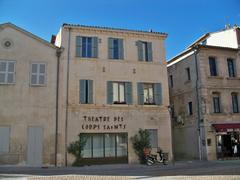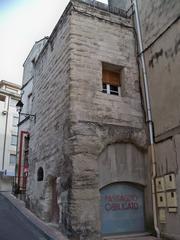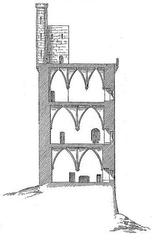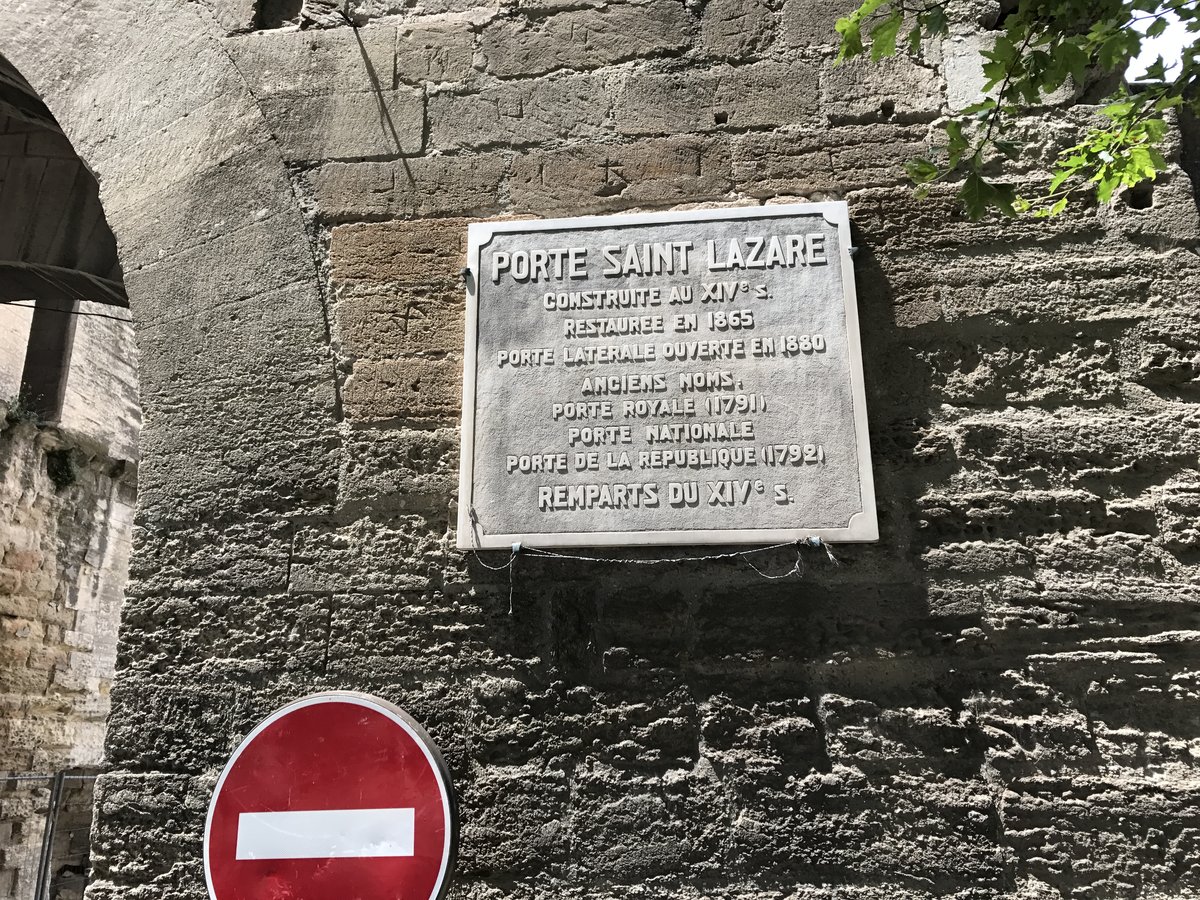
Comprehensive Guide to Visiting Porte de la République Avignon France
Date: 31/07/2024
Introduction
Avignon, a city with a rich historical tapestry, is a must-visit destination for history enthusiasts and cultural explorers alike. One of the city’s most notable landmarks is the Porte de la République, an integral part of Avignon’s ancient fortifications. These walls, primarily constructed in the 14th century, stand as a testament to the city’s medieval military architecture and its historical significance as a papal seat (Wikipedia). The fortifications, including the iconic Porte de la République, offer visitors a glimpse into the past, showcasing the city’s resilience and strategic importance over the centuries. From the early fortifications during the Roman period to the modifications in the 18th century and the military significance during the French Revolution, the walls of Avignon have played a crucial role in the city’s history (Avignon-et-Provence). Today, these walls are part of Avignon’s UNESCO World Heritage sites, attracting tourists from around the world who come to explore the city’s rich cultural heritage and architectural marvels (UNESCO). This comprehensive guide aims to provide visitors with all the essential information they need, from visiting hours and ticket prices to travel tips and nearby attractions, ensuring a memorable and enriching experience in Avignon.
Table of Contents
- Introduction
- Exploring Avignon’s Historical Walls: Visiting Hours, Tickets, and Cultural Significance
- Conclusion
Exploring Avignon’s Historical Walls: Visiting Hours, Tickets, and Cultural Significance
Historical Background
Early Fortifications and Roman Period
The history of Avignon’s fortifications dates back to late antiquity. Contrary to earlier assumptions, recent archaeological findings suggest that Avignon was not defended by a wall during the Roman period. Instead, a rudimentary wall was erected using materials from Roman monuments. This early fortification was centered on the Rocher des Doms and enclosed a much smaller area than the Roman town (Wikipedia).
Medieval Fortifications
During the Albigensian Crusade in the early 13th century, Avignon sided with the Count of Toulouse, Raymond VII. In 1226, King Louis VIII of France, accompanied by a papal legate and a large army, laid siege to Avignon. The city capitulated after three months due to famine, and one of the conditions imposed was the dismantling of its city walls. The town rebuilt its defenses between 1234 and 1237, presumably on the same plan (Wikipedia).
13th Century Double Walls
The 13th century saw the construction of double walls around Avignon. These fortifications were built to protect the city from external threats and were a significant architectural feat of the time. The walls were constructed using local limestone and featured numerous towers and gates, including the Porte de la République (Wikipedia).
18th Century Modifications
In the 18th century, the walls of Avignon continued to be maintained and modified. Between 1755 and 1757, the Porte de la Ligne at the north of the town was rebuilt by architect Jean-Pierre Franque. Similarly, the Porte du Rhône was demolished and rebuilt in a classical style in 1760, and the Porte de l’Oulle was reconstructed in 1783 (Wikipedia).
French Revolution and Military Significance
Between 1796 and 1816-1818, the walls around Avignon were safeguarded due to their military significance. They were placed under the control of the French military, which helped in maintaining their structural integrity. The walls also played a crucial role in the collection of the octroi, a tax on goods brought into the town, which was reintroduced in 1800 after being abolished during the French Revolution (Wikipedia).
19th Century Developments
The 19th century brought significant changes to Avignon, including the modernization of its infrastructure. The Rue de la République, initially called Bonaparte Street, was opened to improve access to the city center. This period also saw the transformation of the Popes’ Palace into a military barracks. Despite these changes, the population of Avignon grew from 20,000 in 1801 to 48,000 in 1906 (Avignon-et-Provence).
20th Century and World Wars
The 20th century was marked by the devastation of two World Wars. Avignon lost 1,200 of its sons in World War I, and the city was occupied by the German army during World War II. The months preceding the liberation were particularly painful, with allied bombings causing significant casualties and damage. The city was finally liberated by Franco-American troops on August 25, 1944 (Avignon-et-Provence).
Modern-Day Significance
Today, the Porte de la République stands as a testament to Avignon’s rich history. It serves as one of the main gateways to the old city, located directly across from Avignon’s Central Train Station. The tree-lined street within the city ramparts that leads to the city center is called Cours Jean Jaures (Avignon France Tourist Information).
The walls of Avignon, including the Porte de la République, are among the best examples of fortified fences still existing in France. The walled enclosure of the old city, built between 1355 and 1370, was protected by 35 main towers, 50 secondary towers, seven doors with drawbridges, and a moat 4 meters deep (Daniela Santos Araujo).
Cultural and Architectural Heritage
The Porte de la République and the surrounding walls are part of Avignon’s UNESCO World Heritage sites. The city’s medieval streets and historic buildings have inspired many, from Catholic popes to artists. The walls not only served as a defense mechanism but also played a crucial role in the city’s economic and social life (Culture Trip).
Visitor Information
Visiting Hours
The walls and the Porte de la République are accessible year-round. However, specific sites within the walls, like museums or historical buildings, may have limited visiting hours. It is advisable to check the official website of Avignon tourism for the most accurate information.
Ticket Prices
While wandering around the walls and the Porte de la République is generally free, certain attractions within the walls may require tickets. Prices can vary depending on the site, so it’s best to look up individual attractions for detailed pricing.
Accessibility
The main access points, like the Porte de la République, are well maintained and accessible. However, some parts of the old fortifications may be challenging to navigate for visitors with mobility issues. It’s recommended to check accessibility options in advance.
Travel Tips
- Wear comfortable shoes as exploring the fortifications involves a fair amount of walking.
- Visit early in the morning or late afternoon to avoid the crowds and enjoy the best lighting for photography.
- Consider guided tours to gain deeper insights into the history and significance of the walls.
Nearby Attractions
Lambert Collection
The Lambert Collection, a contemporary art museum, is located approximately 300 meters from the Porte de la République. The museum is housed in two 18th-century buildings and features both permanent and temporary exhibitions (Daniela Santos Araujo).
Other Notable Sites
- The Popes’ Palace: A historic palace that served as the papal residence during the 14th century.
- Pont Saint-Bénézet: A famous medieval bridge with a rich history.
- Avignon Cathedral: A beautiful cathedral with stunning architecture.
Special Events and Guided Tours
Various events and guided tours are available throughout the year, offering unique experiences and insights into Avignon’s history. Check the official tourism websites for the latest information on upcoming events and tours.
Photographic Spots
- The top of the Rocher des Doms offers panoramic views of the city and its walls.
- The area around Porte de la République is ideal for capturing the grandeur of the fortifications.
- The medieval streets within the walls provide picturesque backdrops for photography.
FAQ
Q: What are the best times to visit Avignon’s walls? A: Early morning or late afternoon is ideal to avoid crowds and enjoy the best lighting for photography.
Q: Are there any guided tours available? A: Yes, various guided tours are available. Check the official tourism websites for details.
Q: Is there an entrance fee to visit the walls? A: Access to the walls and the Porte de la République is generally free, but some attractions within may require tickets.
Q: Are the walls accessible to visitors with mobility issues? A: Main access points are well maintained, but some areas may be challenging. It’s advisable to check accessibility options in advance.
Conclusion
The Porte de la République and Avignon’s historical walls are not just remnants of the past but symbols of resilience and cultural heritage. Visitors can explore these fortifications, delve into the rich history, and experience the city’s vibrant culture. Don’t miss the chance to visit this UNESCO World Heritage site and immerse yourself in the historical ambiance of Avignon.
For more information, download our mobile app or follow us on social media for the latest updates and travel tips.
References
- Wikipedia. (2023). Walls of Avignon. Retrieved from Wikipedia
- Avignon-et-Provence. (2023). City Walls of Avignon. Retrieved from Avignon-et-Provence
- UNESCO. (2023). Historic Centre of Avignon: Papal Palace, Episcopal Ensemble, and Avignon Bridge. Retrieved from UNESCO
- Avignon France Tourist Information. (2023). Porte de la République. Retrieved from Avignon France Tourist Information
- Daniela Santos Araujo. (2023). Avignon Itinerary. Retrieved from Daniela Santos Araujo
- Fearless Female Travels. (2023). Things to Do in Avignon, France. Retrieved from Fearless Female Travels
- Where and When. (2023). Best Time to Go to Avignon. Retrieved from Where and When
